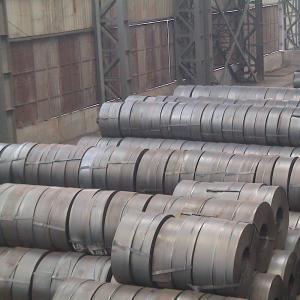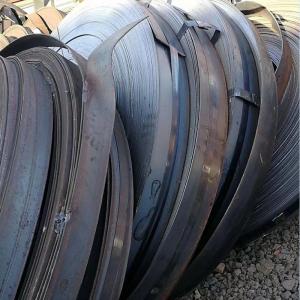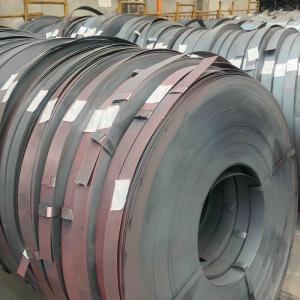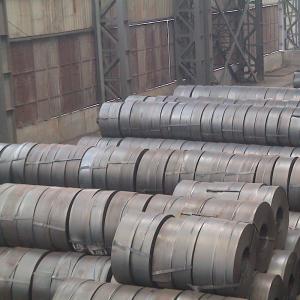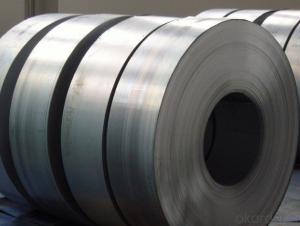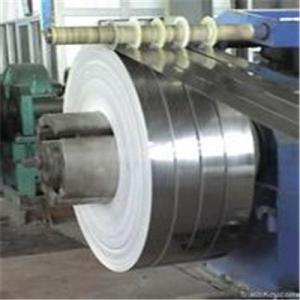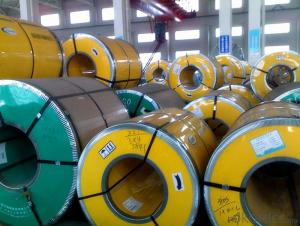Hot Rolled Steel Strip Coil Q195 Q235 in China
- Loading Port:
- Shanghai
- Payment Terms:
- TT or LC
- Min Order Qty:
- 25 m.t.
- Supply Capability:
- 1000000 m.t./month
OKorder Service Pledge
OKorder Financial Service
You Might Also Like
Item specifice
Applications of Steel Strip Coils:
1:Chemical industry equipment, Industrial tanks
2:Medical Instruments,Tableware, Kitchen utensil,kitchen ware
3:Architectural purpose, Milk & Food processing facilities
4:Hospital Equipment, interior Exterior decoration for building
5:Architectural purposes, escalators, kitchen ware,vehicles
Festures of Steel Strip Coils:
1. Each coil is closely covered by oil paper or plastic film.
2. Outside it is firmly packed with sack cloth or compound paper.
3. Steel strap or PP strap to pack the outside to ensure safety.
4. On/about 1000kgs to be packed with one wooden pallet.
5. Strips can be loaded to 20'FCL without pallet if required by customer.
6. LCL shipment can also be arranged once required by the customer.
Specifications of Steel Strip Coils:
| Description | Hot Rolled Steel Strip |
| Specification | 1.2-6.0mm*70mm |
| Standard | AISI, ASTM, BS, DIN, GB, JIS |
| Material | Q195,Q215,Q215B,Q235,Q235B |
| Application | Widly used in welding steel pipes, and bicycle making etc. |
| MOQ | 20 tons or according to customers’ requirement. |
| Port of Delivery | Tianjin Port of China |
| Remarks | We can provide qualify goods,competitive price and speedy delivery |
Images of Steel Strip Coils:
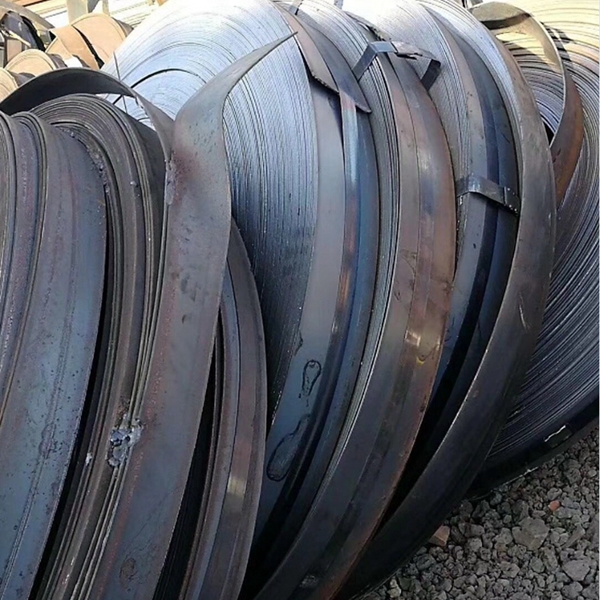
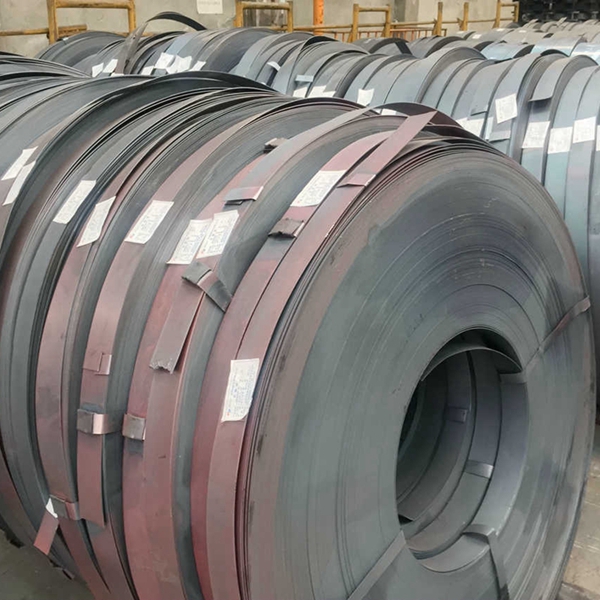
FAQ
1.What's your MOQ?
25MT, it is for one container.
2.Do you have QC teams?
Yeah, sure, our QC team is very important, they will keep the quality control for our products.
3. What's your normal delivery time?
Our delivery time about 10-20days for standard sizes, if you have other requirements like hardness and width ,it is about 20-40days.
- Q:What are the different steel strip rolling processes?
- There are several different steel strip rolling processes that are commonly used in the manufacturing industry. These processes involve shaping and reducing the thickness of steel strips to meet specific requirements. One of the most common processes is hot rolling, which involves heating the steel to high temperatures and passing it through a series of rollers. This process not only reduces the thickness of the steel strip, but also improves its mechanical properties and surface finish. Hot rolling is often used to produce steel strips for structural applications. Another process is cold rolling, which is performed at room temperature. This process is used to further reduce the thickness of the steel strip and improve its dimensional accuracy and surface finish. Cold rolled steel strips are often used in industries such as automotive and appliance manufacturing, where high precision and quality are required. A variation of cold rolling is skin pass rolling, which involves a light cold rolling pass to improve the surface finish and remove defects on the steel strip. Skin pass rolling is commonly used in the production of high-quality steel strips for applications such as electrical transformers and electrical appliances. Additionally, temper rolling is a process used to improve the flatness and shape of the steel strip. It involves passing the strip through a series of rolls with controlled tension to relieve internal stresses and achieve the desired flatness. Furthermore, there are also specialized rolling processes such as annealing and galvanizing. Annealing involves heating the steel strip to a specific temperature and then slowly cooling it to improve its mechanical properties and reduce internal stresses. Galvanizing is a process where a layer of zinc is applied to the steel strip to provide corrosion resistance. Each of these steel strip rolling processes has its own advantages and is used for specific applications. The choice of the process depends on factors such as the desired properties of the steel strip, the required thickness reduction, and the intended application of the final product.
- Q:How do steel strips compare to other materials in terms of recyclability?
- Steel strips are highly recyclable and have one of the highest recycling rates among all materials. They can be easily melted down and reprocessed without losing their quality, making them a sustainable choice for various industries.
- Q:What are the common defects found in steel strips?
- Some common defects found in steel strips include surface scratches, rust or corrosion, uneven thickness, edge cracks, and waviness.
- Q:What are the research and development efforts in steel strip technology?
- Various areas have been the focus of research and development efforts in steel strip technology, with the goal of improving the quality, performance, and efficiency of steel strip production. One particular area of research involves the development of advanced steel strip alloys that possess enhanced mechanical properties, such as increased strength and enhanced resistance to corrosion. This entails analyzing the microstructure and composition of different alloys and optimizing their processing parameters in order to achieve the desired properties. Improving manufacturing processes is another important aspect of research and development in steel strip technology. Innovations in processing techniques, such as continuous casting, hot rolling, and annealing, have been pursued in order to produce steel strip of high quality with minimal defects and dimensional consistency. The impact of process variables, such as temperature, rolling speed, and cooling rate, on the final product properties is also studied. Furthermore, efforts are being made to explore new coating and surface treatment technologies for steel strip. The objective of these endeavors is to enhance the surface properties of steel strip, including corrosion resistance, paint adhesion, and aesthetic appearance. Various coating techniques, such as electroplating, hot-dip galvanizing, and organic coatings, are being examined to identify the most effective and environmentally friendly solutions. Additionally, research in steel strip technology is also directed towards improving the energy efficiency and sustainability of steel strip production. This involves developing energy-saving processes, implementing recycling techniques for waste materials, and utilizing renewable energy sources in the manufacturing of steel strip. In summary, the research and development efforts in steel strip technology are focused on continuously enhancing the quality, performance, and sustainability of steel strip products to meet the evolving demands of industries such as automotive, construction, and packaging.
- Q:How are steel strips used in the manufacturing of material handling equipment?
- Material handling equipment commonly utilizes steel strips for a variety of purposes. The construction of frames and structures is one of the primary applications for steel strips. By providing high strength and durability, steel strips enable the equipment to withstand heavy loads and operate efficiently in demanding environments. Additionally, steel strips are employed in the fabrication of essential components like brackets, supports, and reinforcements. These components are crucial for ensuring the stability and functionality of material handling equipment. Manufacturers can easily shape, cut, and weld steel strips to create customized components that meet specific design requirements. Furthermore, steel strips are frequently used in the production of conveyor belts and chains for material handling equipment. These belts and chains are responsible for the transportation of goods, and steel strips provide the necessary strength and resistance to ensure smooth operation and long-lasting performance. Moreover, steel strips are utilized in the manufacturing of blades and cutting tools used in material handling equipment. These tools are vital for cutting, shearing, and shaping materials, and the strength and hardness of steel strips make them ideal for such applications. In summary, steel strips are essential in the manufacturing of material handling equipment due to their strength, durability, and versatility. Their use in frames, components, conveyor belts, and cutting tools ensures that the equipment can handle heavy loads, withstand harsh conditions, and perform efficiently in various material handling operations.
- Q:Can steel strips be welded together?
- Yes, steel strips can be welded together. Welding is a common method used to join steel strips by heating the edges and fusing them together, creating a strong and continuous bond.
- Q:How are steel strips annealed for improved ductility?
- Steel strips are annealed for improved ductility through a process called annealing. Annealing involves heating the steel strips to a specific temperature and then slowly cooling them down. This process helps to eliminate any internal stresses and improve the ductility of the steel. The first step in annealing steel strips is heating them to a temperature above their recrystallization temperature. This temperature varies depending on the composition of the steel, but it is typically around 1000 to 1100 degrees Celsius. By heating the steel strips above this temperature, the existing grain structure is broken down, allowing new grains to form during the cooling process. After reaching the desired temperature, the steel strips are slowly cooled down. This slow cooling process, also known as controlled cooling or furnace cooling, is essential for achieving the desired ductility. It allows the newly formed grains to grow and align in a way that reduces internal stresses and promotes better ductility. The cooling rate during annealing is crucial as rapid cooling can lead to the formation of undesirable crystal structures and potentially reduce the ductility of the steel. Therefore, the cooling process is typically done in a controlled environment, such as a furnace, to ensure a gradual and uniform cooling rate. Overall, annealing steel strips for improved ductility involves heating them to a specific temperature above their recrystallization temperature and then slowly cooling them down. This process helps to eliminate internal stresses and promote the growth of new grains, resulting in improved ductility and better mechanical properties for the steel strips.
- Q:How are steel strips stored?
- Steel strips are typically stored in a controlled environment to prevent any damage or deterioration. They are usually kept in warehouses or storage facilities that are clean, dry, and well-ventilated. The strips are stored on racks or shelves, with each strip being properly labeled for easy identification and retrieval. To ensure the longevity of the steel strips, they are often stored in a horizontal position, stacked neatly on top of each other to minimize any bending or warping. Adequate space is maintained between each stack to allow for easy access and inspection. Additionally, heavy-duty packaging materials such as wooden pallets or plastic wrapping are used to protect the strips from moisture, dust, and other potential contaminants. It is important to store steel strips away from any corrosive substances or chemicals that could cause damage to the material. Therefore, storage areas are typically kept separate from areas where such substances are present. Some storage facilities also have climate control systems to regulate temperature and humidity, which helps prevent corrosion and other forms of degradation. Regular inspections are conducted to check for any signs of damage or deterioration, such as rust or deformation. Any damaged or compromised steel strips are promptly replaced or repaired to maintain the quality and integrity of the stored materials. Overall, the storage of steel strips involves careful organization, protection, and regular maintenance to ensure their quality and usability for various industrial applications.
- Q:What are the different surface laminating options for steel strips?
- There are several surface laminating options for steel strips, including hot-dip galvanizing, electroplating, powder coating, and painting.
- Q:What are the cleaning methods for steel strips?
- There are several cleaning methods that can be used for steel strips. One common method is mechanical cleaning, which involves the use of abrasives or brushes to remove dirt, rust, and other contaminants from the surface of the steel strips. This method is effective for removing loose particles and can be done manually or using automated equipment. Chemical cleaning is another method commonly used for steel strip cleaning. This involves the use of chemicals such as solvents, acids, or alkaline solutions to dissolve or loosen dirt and contaminants from the surface of the steel strips. The choice of chemical will depend on the type and degree of contamination present on the strips. Ultrasonic cleaning is another effective method for cleaning steel strips. This method utilizes high-frequency sound waves to create microscopic bubbles in a cleaning solution. These bubbles implode when they come into contact with the steel strips, removing dirt and contaminants from the surface. Ultrasonic cleaning is particularly effective for cleaning small and intricate parts of the steel strips. Electrolytic cleaning is another method that can be used for steel strip cleaning. This method involves immersing the steel strips in an electrolytic solution and passing an electric current through them. The electric current causes a chemical reaction that removes dirt and contaminants from the surface of the strips. In addition to these methods, steam cleaning and pressure washing can also be used for steel strip cleaning, depending on the specific requirements and condition of the strips. It is important to choose the appropriate cleaning method based on the type and extent of contamination present on the steel strips, as well as considering any specific requirements or limitations of the cleaning process.
1. Manufacturer Overview |
|
|---|---|
| Location | |
| Year Established | |
| Annual Output Value | |
| Main Markets | |
| Company Certifications | |
2. Manufacturer Certificates |
|
|---|---|
| a) Certification Name | |
| Range | |
| Reference | |
| Validity Period | |
3. Manufacturer Capability |
|
|---|---|
| a)Trade Capacity | |
| Nearest Port | |
| Export Percentage | |
| No.of Employees in Trade Department | |
| Language Spoken: | |
| b)Factory Information | |
| Factory Size: | |
| No. of Production Lines | |
| Contract Manufacturing | |
| Product Price Range | |
Send your message to us
Hot Rolled Steel Strip Coil Q195 Q235 in China
- Loading Port:
- Shanghai
- Payment Terms:
- TT or LC
- Min Order Qty:
- 25 m.t.
- Supply Capability:
- 1000000 m.t./month
OKorder Service Pledge
OKorder Financial Service
Similar products
New products
Hot products
Hot Searches
Related keywords
